Cartesian cats: features of the breed, nature and rules of care
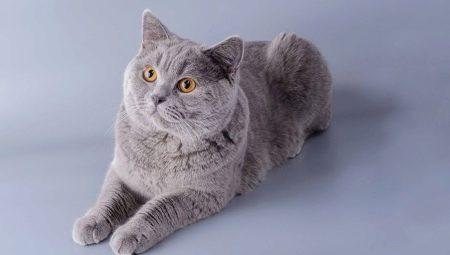
Cartesian cats look like British cats at first glance, but in fact they are of natural origin. These animals are from France, very rare. However, the difficulties of finding a unique kitten are more than compensated for by its attractive appearance, positive character and high intelligence.
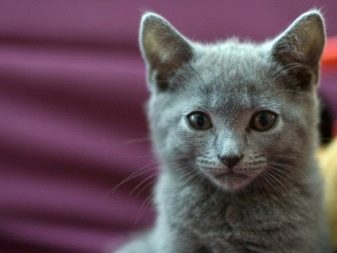
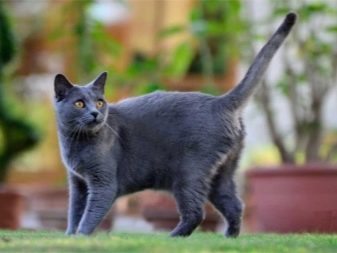
Origin story
Cartesian cats belong to the aboriginal breed. The latter means that they appeared naturally, without human influence. Rather, it was minimal - a person brought the ancestors of the chartreuse into the territory of France (another name for this breed). It is believed that these people were crusaders, and they brought the descendants of Pallas' cat and Egyptian cats to French soil. However, this is not known for certain.
There is another theory. According to her, the cats were brought from the Arabian Peninsula and from Africa by merchants. There is an opinion that the person did not participate at all in the process of the appearance of the chartreuse. By the way, this name has Spanish roots and means the local very soft and pleasant to the touch woolen fabric. It appeared only in the 17th century and originally meant any cat with blue fur.
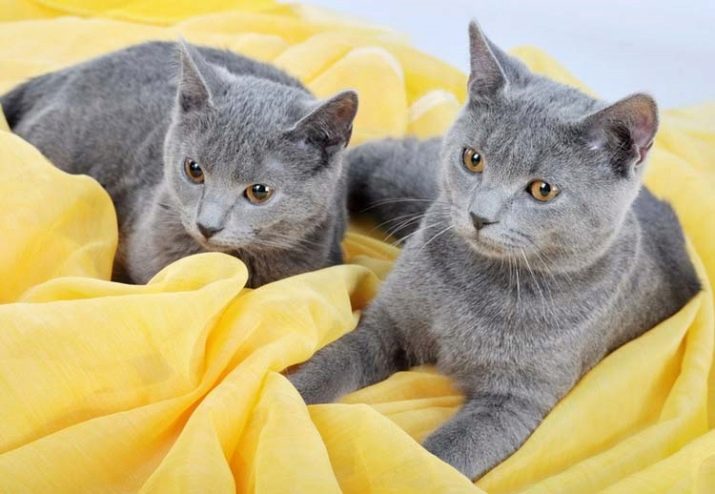
The second name (appeared earlier), Cartesian cats, is associated with the monastery of the Carthusian order. In the "neighborhood" with monks, cats have been seen since the 16th century. Living in the monastery, cats caught mice, thereby developing their hunting skills. For this, and were held in high esteem by the monks, the latter even dedicated poetry to the monastery mice. At that time they were in almost every yard and were called commoners' cats. From this name it is clear that they were not of particular value.
During the Hundred Years War and the accompanying famine, Cartesian cats were exterminated - their meat was used for food, and their fur was used for clothing.
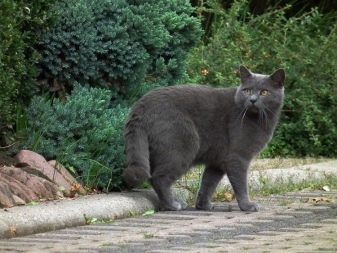
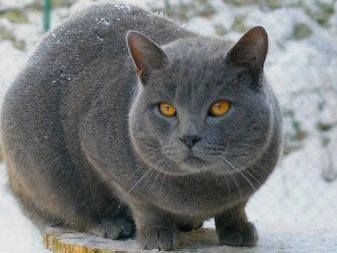
After the war, their numbers decreased to a critical level, so phenologists took care of the protection and preservation of individuals. Work began on the standardization of the breed and after the Second World War cats were considered a rarity, which affected their value. In Europe, the Chartreuse again almost fell under a decline in the population, since the British were popular. The Cartesian cat was proposed to be combined with the British breed. Fortunately, this was prevented by the growing popularity of chartreuse in the United States.
Since the 60s of the last century, Cartesian cats have appeared as pets of the richest and most famous people in the state. The breeders defended the right of the Cartesian individuals to a separate species, which is quite true, since they are qualitatively different from the British not only in the characteristics of their fur and character, but also in their genotype. Today the breed is considered well-established and includes short-haired blue-gray cats with yellow or copper eyes.
Today, the breed meets the standards adopted at the beginning of the twentieth century, the breed is clean, largely thanks to American and French breeders.
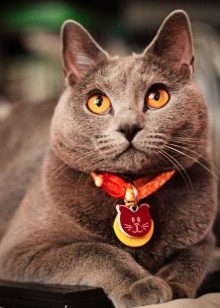
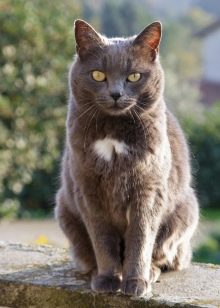
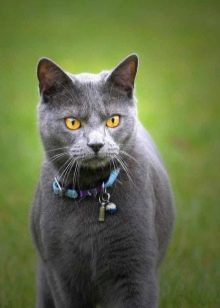
Description
The animal is of medium size. Cats are usually larger than cats. The weight of an adult varies from 4 to 9 kg, so cats are often referred to as large cats. Despite the rather large weight, individuals differ agility and agility... The body of the Cartesian individuals is muscular - with broad and powerful shoulders and chest. The paws are rather short, which, in combination with the muscularity of the body, gives the impression of a stocky animal. If we talk about specific numbers, then about 30 cm at the withers. However, this indicator is not prescribed by the breed standard.
Adult animals, in addition, are distributed in breadth, which gives additional volume to the animal's body. The neck is short, powerful, extending into the back. Often, with abundant nutrition, a noticeable fold forms on the nape of the neck. Feet seem rather thin for such a large body. The anterior ones are stronger and visually often longer than the hind ones. The brushes are large, with long claws.
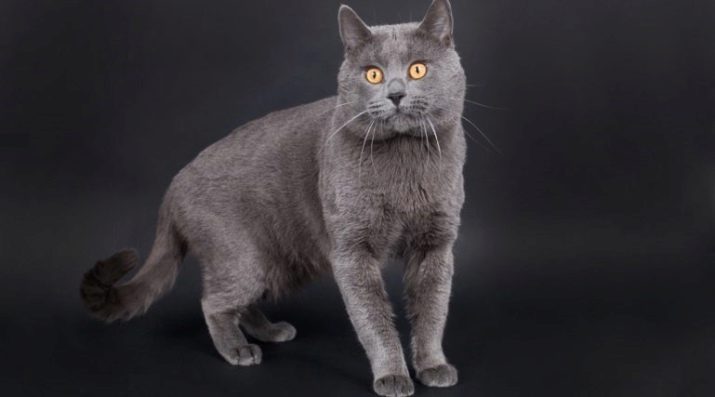
The back is also quite strong, broad and straight. The tail is oblong and tapers towards the tip. The head resembles an inverted trapezoid, on which medium-sized ears "stand", raised high up. The rounded forehead gently "flows" into a straight gray-blue nose. Pillows are pronounced, combined with chubby cheeks, which is why the animal's muzzle has a good-natured look.
If you look at the face, it seems that the cat is smiling. This is due to the unusual placement of the whisker pads and the peculiarities of pigmentation. Eye color is closer to golden orange (from honey to copper). An important point is that the presence of a greenish tint in the color of the eyes is unacceptable (this is one of the signs by which you can distinguish a Cartesian cat from a Russian blue). The eyes are round, large, in most cases close-set. The look of the animal is expressive, intelligent, attentively studying.
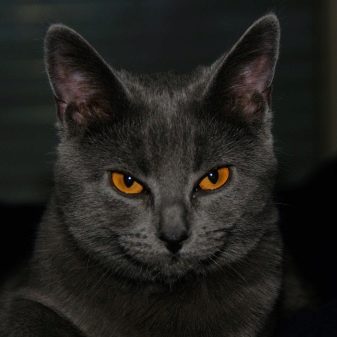
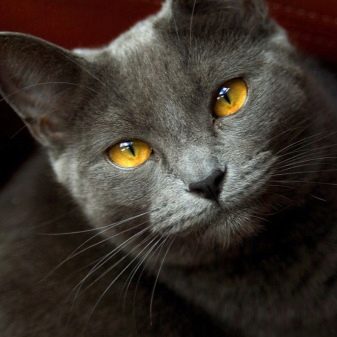
According to the breed standard, the animal is blue in color, the guard hairs at the ends have a silvery tint. Because of this, the fur coat seems especially shiny, iridescent. The undercoat and the rest of the fur are completely identical in tone, which creates a feeling of a special splendor of the fur coat, gives the effect of "double" fur. The paw pads and nose should also be gray. All deviations are considered marriage.
It is important that the blue tint is uniform over the entire surface of the coat; its transition to purple or pink is unacceptable. The presence of white spots is also considered a marriage. Kittens may have a striped pattern, which is not a marriage. As the animal grows up, it disappears, the fur acquires such a valuable color uniformity.
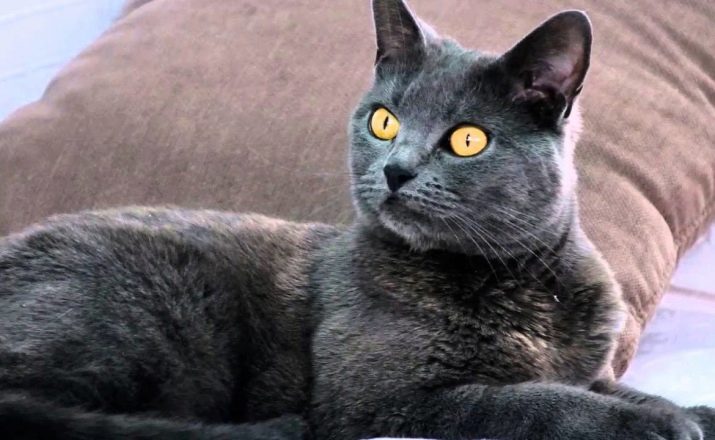
In the absence of genetic diseases and proper care, the Cartesian cat lives for 14-16 years.
Character traits
By nature, Chartreuse is a typical phlegmatic. The cat easily gets along with people and even small family members. It should be noted the calm, non-aggressive nature of the animal, its cleanliness and the ability to quickly assimilate the customs adopted in the house. Chartreuse's favorite pastime is snoozing in a cozy warm place. This is how they spend most of the day. However, during short periods of activity, the animal plays, demonstrating the wonders of dexterity and skill of a born hunter.
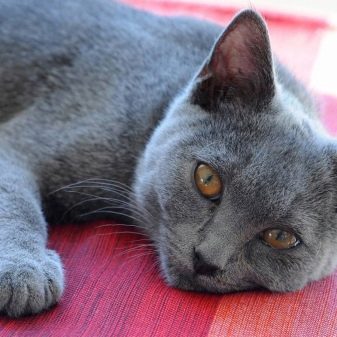
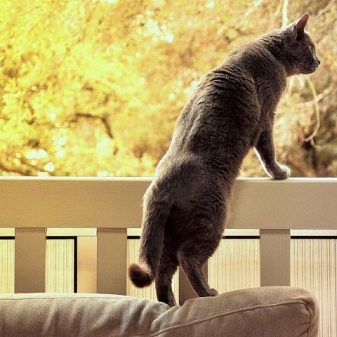
Chartreuse have high intelligence and quickly learn the rules of conduct in the house. However, total training is considered offensive for themselves, and the execution of commands that they noted as optional for themselves is beneath their dignity. It may seem that the animal is wild, but it is not. Chartreuse are devoted to their owner, they love to eat on his lap.
Cartesian cats are delicate and not annoying, if a person is busy, they will not bother, but will wait on the sidelines.
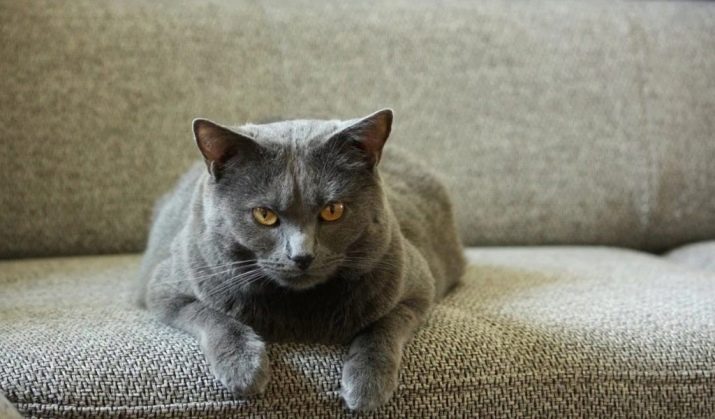
They are tolerant of children, even if babies show their love for the animal unnecessarily. In this case, the pet will try to leave as soon as possible, and it will not do it in a hurry, but with its characteristic grace and aristocracy. Despite the fact that cats are very tolerant of children, they are jealous of other pets towards the owner. That is why you should not keep Cartesian individuals with other pets, they can be cruel to the latter.
They quickly remember the nickname, recognize the owners, and treat the guests favorably. They are even jokingly called the philosophers of the feline world. It seems that in their bliss and sleep they learn some mysterious truth, but nothing cat is alien to them - they are moderately curious, playful. Chartreuse quickly get used to the tray and nail polish. Carthusian cats are hunters by nature, and besides, they are thieves. The cat can easily steal something from the table and eat it. That is why it is important to wean a kitten from such theft from the first days.
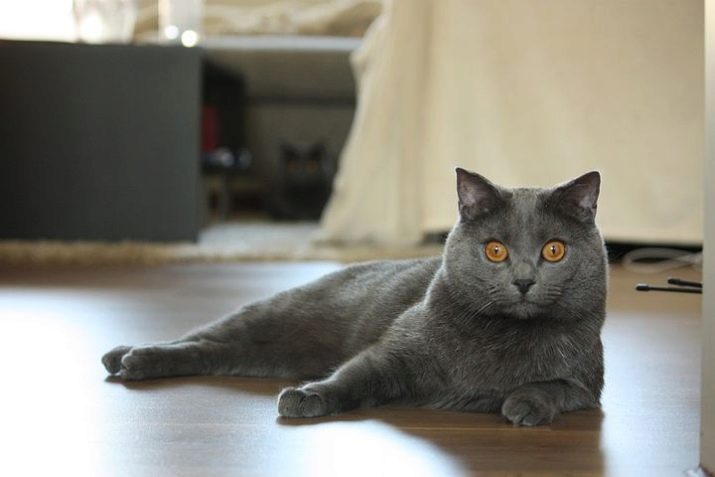
Perhaps, as a positive feature, it is worth noting that cats are quite silent. The Cartesian will not meow when begging for affection or food. If the animal does meow, then it does it very quietly and delicately. Some owners even worry that in case of danger, the pet will not be able to ask loudly for help.
Pros and cons of the breed
The advantage of the representatives of the breed is the character of the animal. Due to their high intelligence, imposingness and some laziness, they are great for keeping in city apartments, they will become a companion for lonely people, and will also be a safe animal in families with children. Despite their aristocratic slowness, Chartreuse are excellent mouse-catchers. In a private home, they will also be useful.
Undoubtedly, the luxurious appearance is another advantage of the breed. They invariably evoke admiration and can participate in exhibitions. It should be noted that at the same time, chartreuse is distinguished by quite good health.
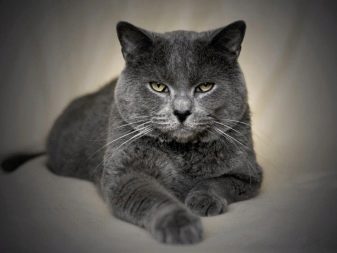
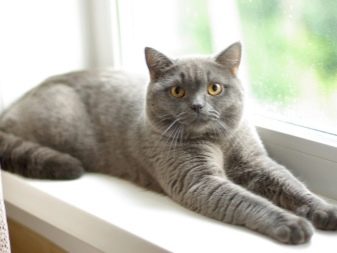
Despite its attractiveness, Carthusian cats are quite unpretentious in grooming, do not require special care for their fur... The quality and color of the latter cannot be influenced by this or that diet (as is the case with the British, for example). But at the same time, the animal's hair causes allergies, and also sheds profusely.
Chartreuse are prone to allergies, which can trigger a number of fatal diseases. For this reason, you should monitor their activity and nutrition.
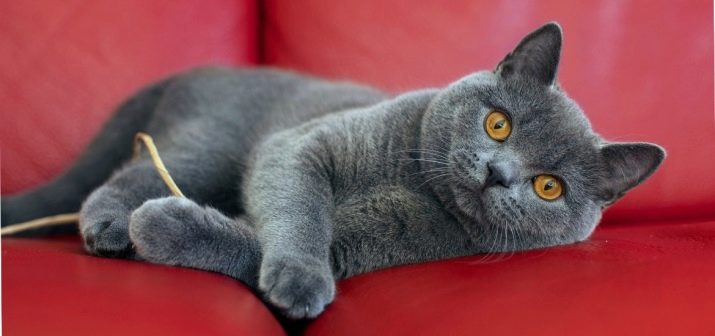
Cartesian cats do not tolerate long separation from their owner, do not like "hugs". In this they are similar to the British - they come for affection when they want it. This breed is very rare, so the cost of a kitten is quite high. Due to the similarity with the British, scammers often pass off the latter as Cartesian cats. It is better to buy a kitten from breeders, making sure of its originality.
If you do not have the proper experience, it is better to entrust the search and selection of a kitten to an independent professional.
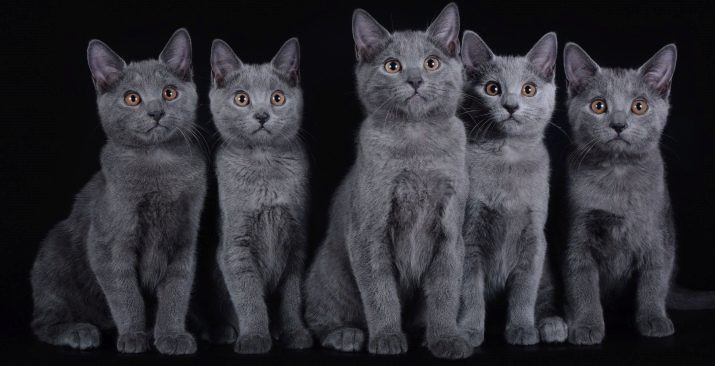
Conditions of detention
The short-haired chartreuse requires a lot of attention to its coat. Usually, it should be brushed out twice a week. For a thick undercoat, a slicker coat is suitable. The guard hair should be brushed with a massage brush. If hairs have fallen out on the body of the animal, they should be collected with a special mitten. During the molting period, these procedures will have to be repeated daily.

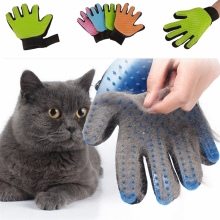
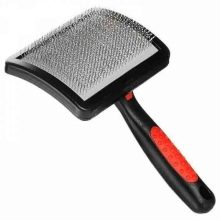
You should not bathe your pet often, as a rule 2-3 times a year is enough. Like most cats, Chartreuse do not like water treatments and can behave somewhat inappropriately. For bathing, use water with a temperature of + 37– + 38 ° C and a special shampoo. It is not so easy to soak a pet's thick undercoat with water, so first, the pet's coat is moistened abundantly, and then shampoo is applied. It is foamed and quickly spread over the entire body, avoiding contact with the face and ears. The shampoo should be gently rubbed into the undercoat and then washed off.
After "bathing procedures" the cat is wrapped in a towel or warm diaper and allowed to dry a little in this form. You can not dry the fur coat of individuals with a hairdryer. This can dry out the pet's coat and skin.
It is best to bathe the animal during the moulting period, which will allow you to quickly and efficiently remove the old coat.
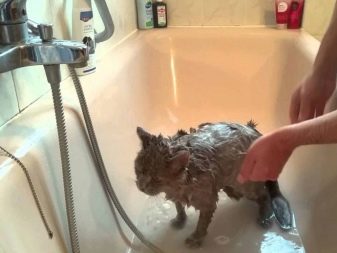
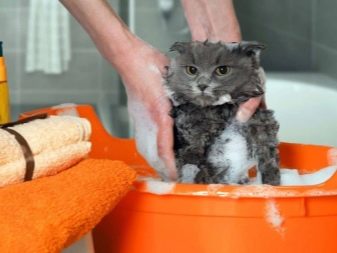
Once every 2-3 weeks, the claws of the animal should be cut, cutting off no more than 2-3 mm. If you cut off the longer part of the nail, there is a risk of damage to the blood vessels. For a haircut, you should get a pruner or a special guillotine.
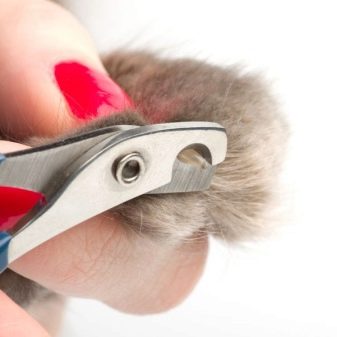
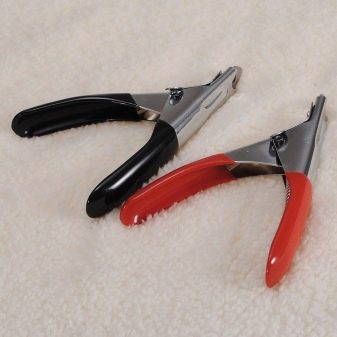
The eyes and ears of the animal should be examined carefully once a week. Usually it is necessary to clean the dirt from the ears. This can be done with a cotton swab dipped in warm clean water or chamomile broth. If discharge occurs, consult a doctor. Often from the eyes of a cat "lacrimal paths" diverge. If necessary, the eyes of the animal are wiped with soft napkins - cloth or paper. It is not recommended to use cotton wool for these purposes.
As for the haircut, according to the standard, it is not provided. You can only trim the protruding hairs. However, at the request of the owner or in extreme heat, the animal can be trimmed, this is done every 1–1.5 months. At least 2 times a year, the animal worms. You may need to do this more often - the exact frequency is usually indicated on the packaging of the worm medicine. With the beginning of a warm spring, the animal should also be treated with a flea-protecting agent. If a Cartesian cat goes outside, be sure to wear a collar.
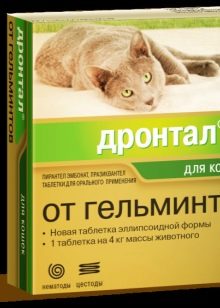
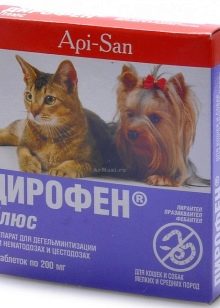
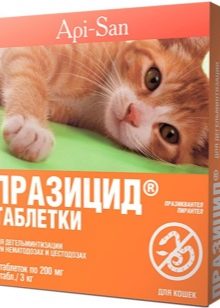
As a rule, chartreuse from small pores is easily accustomed to the tray and breeders take on this care. If you bought a kitten, then it is enough to mark the litter box in your new home with the smell of a cat. As soon as a pet appears in your home, watch it carefully. If the kitten heads to the litter box, reward him after he has done his "business." If trying to find a nook, carry it to the tray. Make sure the animal can climb in and out of the tray on its own.
If the kitten makes a puddle, wash it thoroughly to get rid of the smell.
You can buy a special product at a pet store or use improvised solutions - vinegar, alcohol, potassium permanganate.
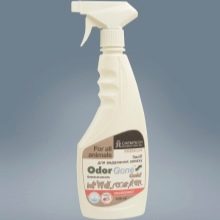
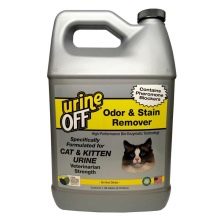
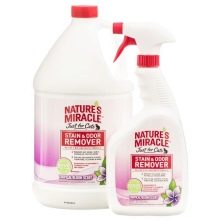
The kitten should also be taught to the scratching post from the first days, it is better to do this during the game. If the kitten begins to tear the furniture (and this will still happen at first), do not scold him, but rather carry him to the scratching post. If the kitten begins to actively use the latter, it should be encouraged by affection or treats.
Due to their natural origin, Cartesian cats boast strong immunity. Their weak point is the hip and knee joints. Dysplasia of the hip joint and dislocation of the knee lead to lameness, loss of mobility of the animal. Preventive measures include a balanced diet, an adequate level of physical activity, and regular check-ups with a veterinarian. In addition to the joints, the cardiovascular system of the animal is also at risk due to excess weight. The preventive measures are the same.
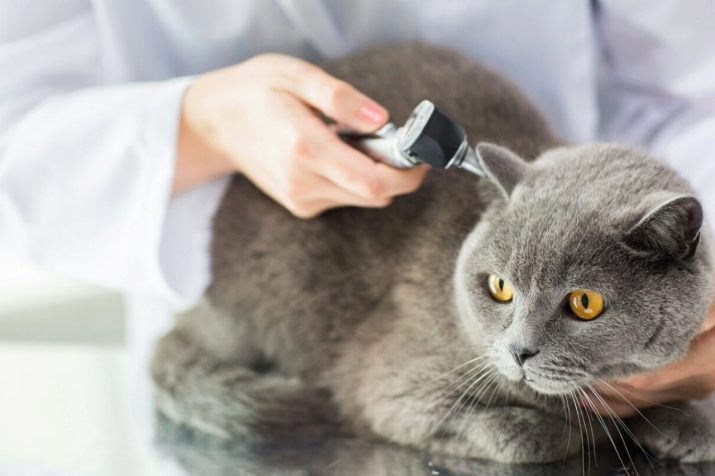
It is important to pay attention to the condition of the teeth during the period of milk molar replacement. This usually occurs at 4-5 months of age. The fact is that these individuals have rather strong milk teeth, they interfere with the growth of molars. At this age, the condition of the kitten's oral cavity should be assessed once a week and, if necessary, immediately contact the veterinarian.
Dental problems include tartar, especially in cats that eat homemade food.
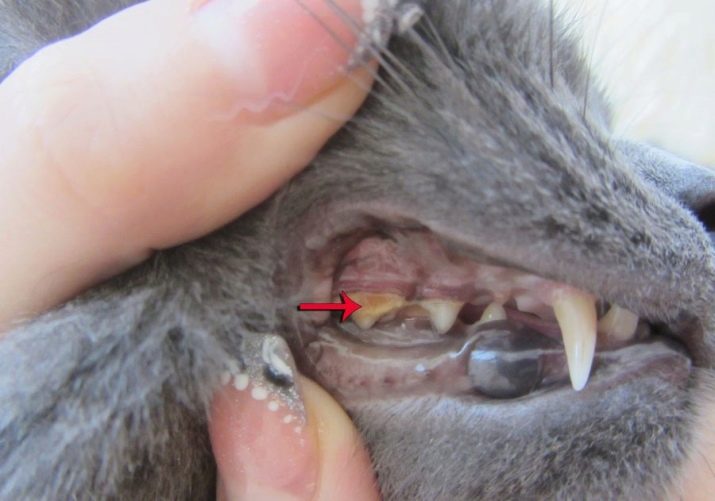
The help of a specialist may also be required in the case of incisors that are too close to each other, which is often found in Cartesian individuals. Another possible problem is gingivitis. The regular use of a special stick, bone, will help prevent the appearance of dental diseases. In individuals who eat dry food, this usually does not occur, since dense food granules by themselves clean off plaque from the pet's teeth.
The breed itself does not strive for walking. However, regular outings will ensure the necessary activity of the animal, avoid obesity and related diseases. If you live in a private house, you can send the cat for independent walks around it. An important point - in the summer heat, the animal quickly overheats, so you still need to control its promenade. For city dwellers, a good option is walking in a park or a forest belt, the cat is kept on a harness.
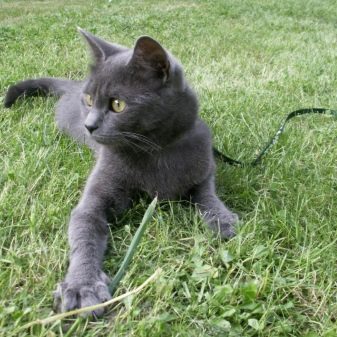
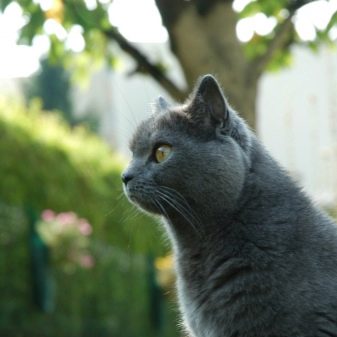
At the age of two years, the animal is considered ready to mate, although it reaches its sexual maturity already at 8–12 months. However, giving birth to such a young female can lead to severe pathologies. Females after two years of age usually stop growing, while males can increase in size up to 5 years.
For mating, only purebred individuals are used, the search for which is best left to a professional.
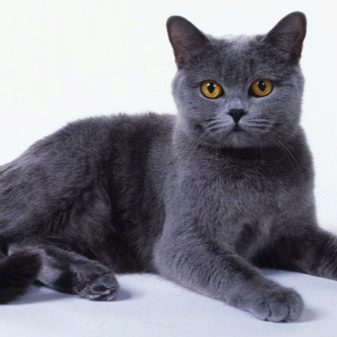
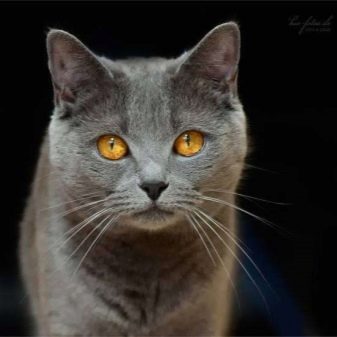
The female's heat lasts from 5 to 10 days. First, the character of the animal changes - the cat becomes either overly affectionate or aggressive. Then the changes concern the posture - when walking, the cat bends its back and raises its tail high. On the third day of estrus, the female begins to meow, calling for a partner. If you stroke the animal at this time, it will lie on its front legs, raising its hindquarters and tail. It is this time that is considered the most successful for knitting.
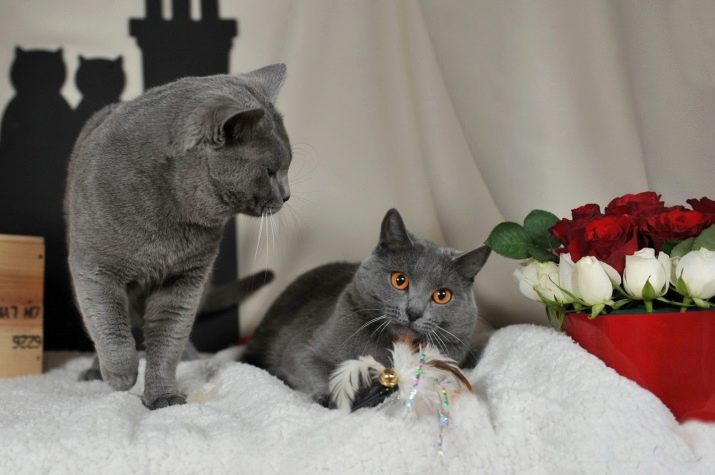
Signs that the cat has reached puberty include more aggressive behavior, meowing, especially in the evening and at night. But the surest "symptom" is that the cat begins to mark. Moreover, urine takes on a particularly specific smell, and it is impossible to detect puddles.
An important point - before mating, animals are examined by a veterinarian, worms are driven. If there is a dislocation of the patella, the individual is considered not suitable for mating. It is better to conduct it on the territory of the partner, so he will feel more confident. It is important not to rush the pets - the cat must get out of the carrier itself, it is worth giving time to the animals to get to know each other, to look around.
To obtain a guaranteed result, the cat is left with the "groom" for several days.
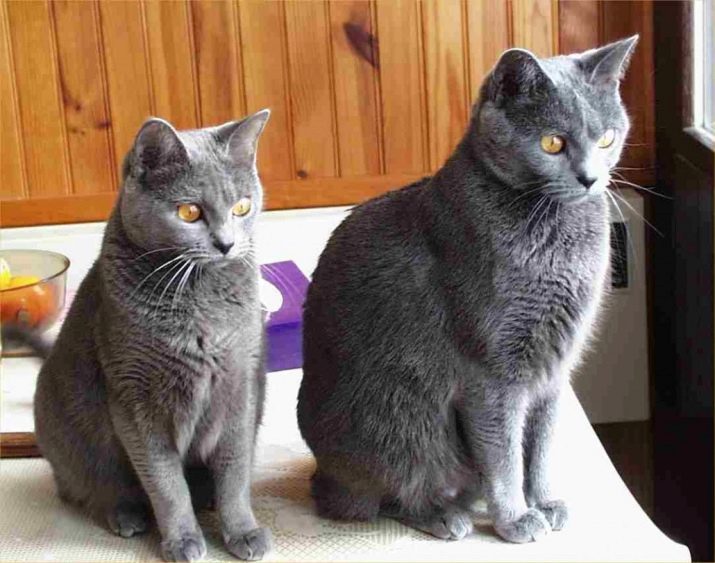
After a successful mating, the cat becomes phlegmatic, spends even more time in a doze. A month later, her tummy is rounded, and 9 weeks after mating, kittens are born. The next estrus may begin within a few days after giving birth. At this point, it is important to exclude the presence of a male next to the female. This can be dangerous for her health and for the kittens.
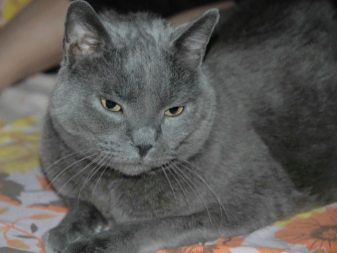
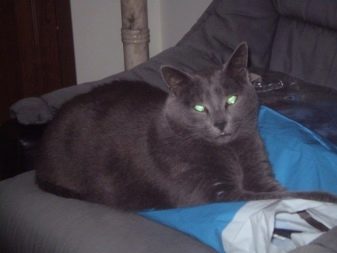
It is not recommended to separate cubs from their mother before 3 months, which ensures their strong immunity and a stable psyche. The first vaccinations for "babies" are given at 9-12 weeks.This is a vaccine against calcivirosis, rhinotracheitis, panleukopenia, chlamydia. Revaccination is performed in 2–4 months. At the eighth week, they are vaccinated against ringworm, at 12 weeks - against rabies, at 16 - against infectious peritonitis. Then all these vaccinations are given once a year according to the vaccination schedule. It turns out that the first vaccinations are usually given by the breeder.
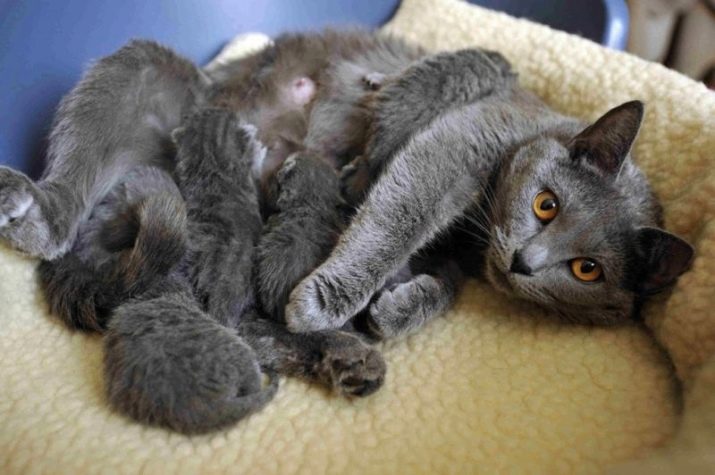
If you are not planning your pet's offspring, you should take care of spaying or neutering them. The first procedure refers to the ligation of the fallopian tubes in cats and the seminal ducts in cats. Sterilization can be performed at any age, but best of all - before the first estrus and up to a year and a half in cats. Despite the fact that sterilization is considered a more gentle operation, it is performed under general anesthesia. An important point - sterilization does not discourage sexual desire.
Castration means the complete removal of the ovaries and uterus (in a cat) and testicles (in a cat). Thanks to this, the animal does not experience sexual attraction and, naturally, does not bear offspring. It is recommended to carry out the operation up to one year. Both procedures are generally easier for cats to tolerate. The latter will need a special blanket during the healing of the stitches.
It should be remembered that after spaying and neutering, animals become more lazy, so they have a higher risk of obesity.
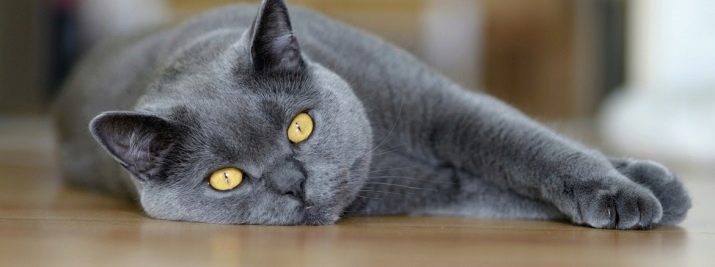
Feeding
It is advisable to decide from the very beginning of raising a kitten - whether you will feed her with homemade food or dry. If possible, the chosen food should be given to the cat throughout its life; it is unacceptable to mix or alternate food from different feeding schemes. Another important thing to remember is the tendency of cats to obesity due to their excellent appetite and low mobility. When choosing dry food, preference should be given to holistic, premium or super premium varieties. Consider the dosage the manufacturer recommends for your age and weight cat.
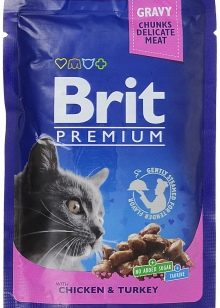
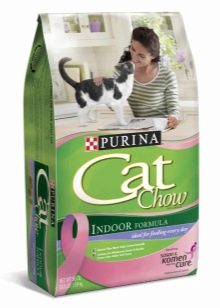
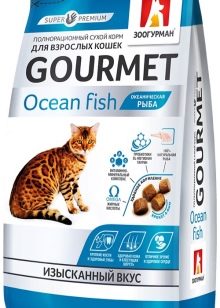
If you are feeding homemade food to your cat, also adhere to the serving size recommendations. It is worth excluding from the pet's menu fatty meats, raw river fish (any) and boiled river fish, sweets, smoked meats, dishes from your table. Milk is given to kittens, it is undesirable for adults, as it can provoke an upset stomach.
An example chartreuse diet might look like this:
- lean meat - beef, rabbit, chicken, turkey; it is better to give meat raw, it can be disinfected by preliminary freezing (for 10-12 hours) and subsequent scalding with boiling water;
- a fish - only seafood and only boiled;
- chicken yolk or quail egg (once a week);
- dairy products - low-fat cottage cheese, fermented baked milk, sour cream;
- vegetables - zucchini, zucchini, broccoli, cauliflower.

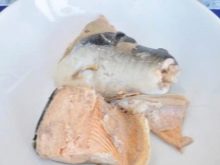
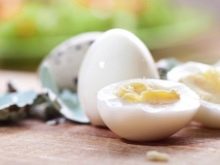
For about six months, kittens are kept on a special diet, and then transferred to an adult diet. It is not recommended to drastically change the pet's diet either during this period or at an older age. When feeding a cat with homemade food, it should be cooked separately, without adding salt or spices. In addition, in this case, it is imperative to give the animal vitamin and mineral complexes. It is advisable to grow special grass for the cat all year round. It can be mixed into food or simply let the pet "graze" on the windowsill, allowing him to pull the grass himself.
Important! There should always be fresh, clean water in the pet's bowl.
All about the Cartesian cats, see the next video.
































